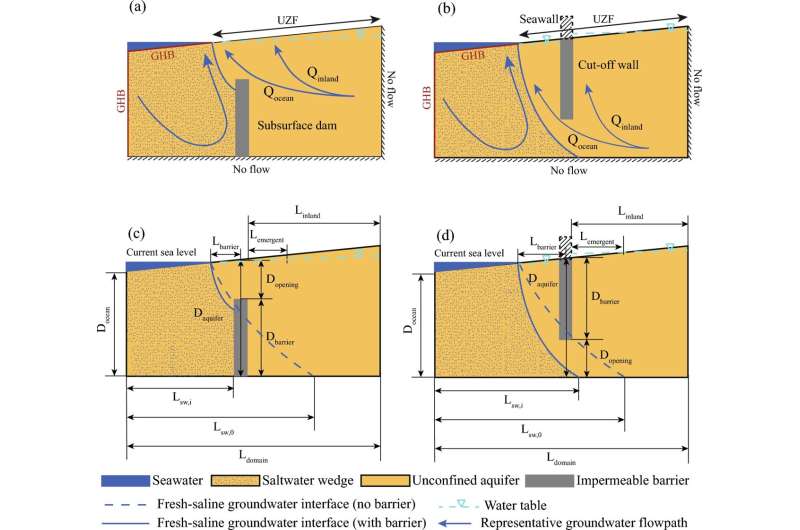This article has been reviewed according to Science X's editorial process and policies. Editors have highlighted the following attributes while ensuring the content's credibility:
fact-checked
peer-reviewed publication
trusted source
proofread
Barriers designed to prevent saltwater intrusion may worsen inland flooding

As Earth continues to warm, sea levels have risen at an accelerating rate—from 1.4 millimeters a year to 3.6 millimeters a year between 2000 and 2015. Flooding will inevitably worsen, particularly in low-lying coastal regions, where more than a billion people are estimated to live. Solutions are needed to protect homes, property and groundwater from flooding and the intrusion of saltwater.
Seawalls and similar infrastructure are obvious options to protect against flooding. In fact, cities such as New York and San Francisco have already thrashed out potential plans with the Army Corps of Engineers that will heavily rely on seawalls. But these plans come with a hefty price tag, estimated at tens of billions of dollars.
Further complicating planning, a new paper has found that seawalls and other shoreline barriers, which extend below the surface, might actually lead to more groundwater flooding, result in less protection against saltwater intrusion into groundwater, and end up with a lot of water to deal with inside of the area that seawalls were supposed to protect.
The article, "Shoreline barriers may amplify coast groundwater hazards with sea-level rise," was published in Scientific Reports. The paper was written by Xin Su, a research assistant professor at the University of Memphis; Kevin Befus, an assistant professor at the U of A; and Michelle Hummel, an assistant professor at the University of Texas at Arlington. Su was previously a post-doctoral researcher working with Befus in the U of A's Geosciences Department before assuming her current position.
The paper provides an overview of how sea-level rise causes salty groundwater to move inland and replace the fresh groundwater that was there, a process known as saltwater intrusion. At the same time, the fresh and salty groundwater both rise toward the ground surface because of the higher sea level. This can cause flooding from below, also known as groundwater emergence.
Walls can be built underground to reduce saltwater intrusion, but this can lead to groundwater getting stuck behind the walls, which act like an underground dam. This can cause even more groundwater to move up to the ground surface, which can in turn infiltrate sewer systems and water mains.
"These barriers can backfire if they don't take into account the potential for inland flooding caused by rising groundwater levels," Su explained. "Excessive groundwater could potentially reduce sewer capacity, increase the risk of corrosion and contaminate the drinking water supply by weakening the pipes."
The researchers noted that studies prior to this one did not include the groundwater flooding effects, which led those studies to anticipate more benefits from underground walls than this latest paper now suggests.
"The standard plan for protecting against flooding is to build seawalls," Befus added. "Our simulations show that just building seawalls will lead to water seeping in under the wall from the ocean as well as filling up from the landward side. Ultimately, this means if we want to build seawalls, we need to be ready to pump a lot of water for as long as we want to keep that area dry—this is what the Dutch have had to do for centuries with first windmills and now large pumps."
Su concluded, "We found that building these protection barriers without accounting for potential inland flooding risks from groundwater can eventually worsen the very issues they aim to solve."
She added that "these risks highlight the need for careful planning when building barriers, especially in densely populated coastal communities. By addressing these potential issues, coastal communities can be better protected from rising sea levels."
When building flood-related or underground walls, there appears to be no perfect solution that prevents saltwater intrusion or groundwater flooding. As such, the researchers recommend that any underground barriers have additional plans to deal with the extra water that would pond up inland from the barrier, such as using pumps or French drains, which utilize perforated pipes embedded in gravel or loose rock that direct water away from foundations.
City planners in New York, San Francisco and coastal cities globally would do well to take heed of this as they develop plans to combat rising sea levels.
More information: Xin Su et al, Shoreline barriers may amplify coastal groundwater hazards with sea-level rise, Scientific Reports (2024). DOI: 10.1038/s41598-024-66273-w
Journal information: Scientific Reports
Provided by University of Arkansas




















